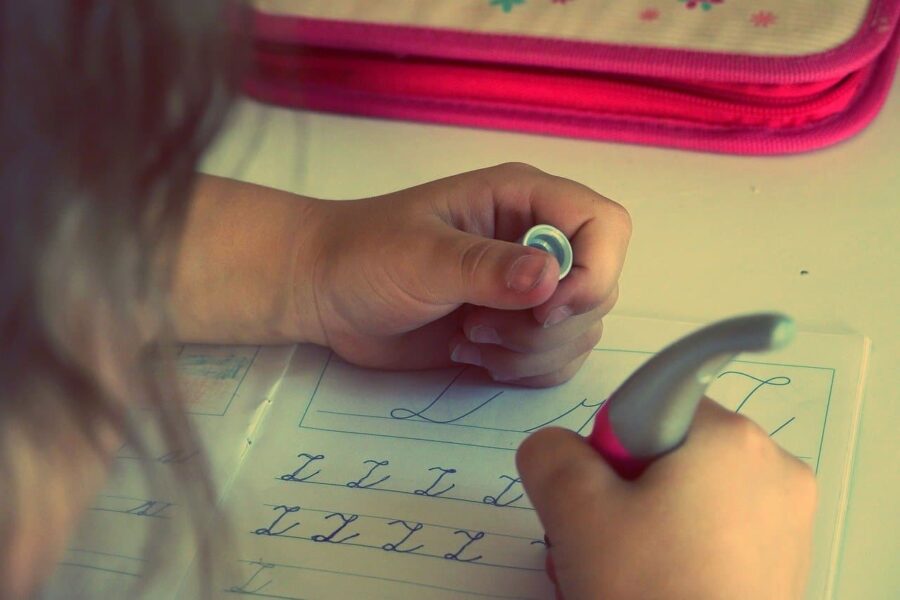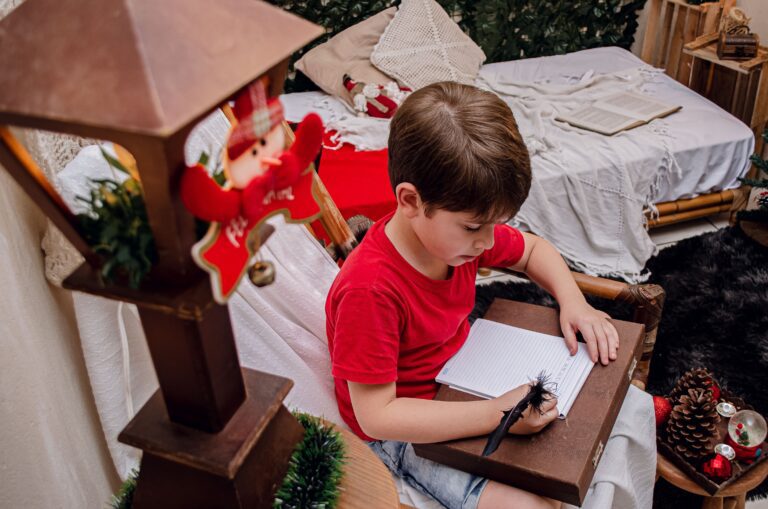Support Young Writers by Separating the Skills

Do your creative children freeze or moan when it comes to actually putting their ideas down on paper? Sometimes we forget how many complex skills writing actually involves. When a child sits down to write, there’s a lot to remember.
“How do I form that letter? Oh yeah, finger space between the words. How do I spell that word? When should I use a capital letter? Do I need a comma?” The mental load is high, especially in the early stages. The challenge can choke creativity.
Separating the skills of composition from the skills of “getting it down” can lift that heavy load. The skills involved are quite different. Offering support is not cheating!
I love how Julie Bogart from Brave Writer compares offering support in writing to how we helped our children learn to tie their shoes. For a long time you did it for them, modelling the process. Then you broke it down into steps and had them try it bit by bit, as they slowly gained confidence. Eventually, they could do it on their own. At first they were slow and the bows weren’t even, but gradually they got faster and the end result looked tidier.
In the same way, as your children build up competence and stamina in the skills of handwriting and spelling, they will gradually become more independent in writing their own thoughts down.
What counts as writing?
Another way to think about the skills being separate is to consider this question. Could a paralyzed person or someone with no arms, still become an author? Yes, of course. They could dictate their ideas to someone or use voice-to-speech technology. Yet they would still be considered the author.
In the same way, we can record our children’s words, helping them see themselves as writers whose words are worth writing down. In doing so, we give them a taste of success which can motivate and move them towards independence.
So go ahead and scribe for your child sometimes. Share the pen. Lift the burden of the mechanics of writing. By taking the role of scribe, we can help capture their creative ideas. Or we can let them use voice-to-text to preserve their words and show them the power of getting their words in print.
Developing writers and struggling writers all need support
Supporting developing writers in this way helps inspire them to write. Struggling learners benefit from this as well. I scribed for my dyslexic son for years, allowing him to develop his writer’s voice while he continued to work on his handwriting and spelling skills separately.
When my children aged seven to ten tackled longer projects, they still tired easily. I often stepped in to record some of their words for them. Sharing the pen helped them persevere.
For example, when my oldest daughter was eight, she wanted to write a story about the mouse we discovered in our house. Although she had chosen that project herself, some days she still got discouraged. When she drooped, we’d chat about where she was stuck. We’d brainstorm possibilities and I’d jot a few sentences down. With confidence restored, she would carry on with renewed energy. The project took several weeks but as we worked together, she grew her skills and completed the project with pride.
More ways to share the pen
Sharing the pen can take different forms. Some children are verbal processors. Loads of ideas buzz in their minds, and they can talk about them all day long. However, when it comes to writing their thoughts down, they freeze. Even older students can be helped if we listen while they talk their ideas out, writing down key words and phrases. Then we can model for them how to take those ideas and play with them, perhaps reordering them, expanding some, discarding others, or saving bits for another piece.
Just having their key words jotted down is enough to help some students get past the intimidation of the blank page. Post-it notes can be a fun way to engage in this with our children. Eventually, they may learn to ‘brainstorm’ in this way for themselves. Some may find it helpful to record themselves talking about their ideas. Then they can listen to the recording and take notes from what they’ve said.
Provide safe places for writing risks
Another way to separate the skills for our children is to provide ‘safe’ places for them to write. Opportunities to write when they know they won’t be critiqued for spelling, grammar and handwriting encourage them to experiment. Freewriting provides one of those safe spaces. Brave Writer shares more about the strategy of freewriting here.
When your children are working on writing projects, let their rough drafts be a safe space to get their thoughts out. Respond to their ideas. Ask questions to help them elaborate. Give enthusiastic praise. Save worrying about spelling and grammar till the tidying up stage. Then partner with them in gentle ways as they learn to edit.
Journals offer another safe space. We used different types of journals in various ways over the years. Some journals were kept completely private. Other times we dialogued back and forth like a conversation. I engaged with their message and modelled correct spelling and grammar but rarely corrected mistakes. Sometimes they wrote in journals about whatever interested them, and I provided support as needed.
What about mechanics?
You may be wondering when and how to focus more deeply on the mechanics of writing. I recommend using copywork and dictation to develop the skills, stamina, and speed needed for fluent independent writing. These methods help children focus on accuracy since they aren’t trying to think creatively at the same time. An added benefit is that comments on any errors they make aren’t personal. To learn more, check out this post about copywork from Notebooking Pages and this one about dictation from Brave Writer.
I’d love to hear how you find ways to separate the skills to spur on your budding writers. Or maybe you have more questions about how to do this with your children. Contact me and let me know.
Some links are affiliate links. Thank you for your support!






